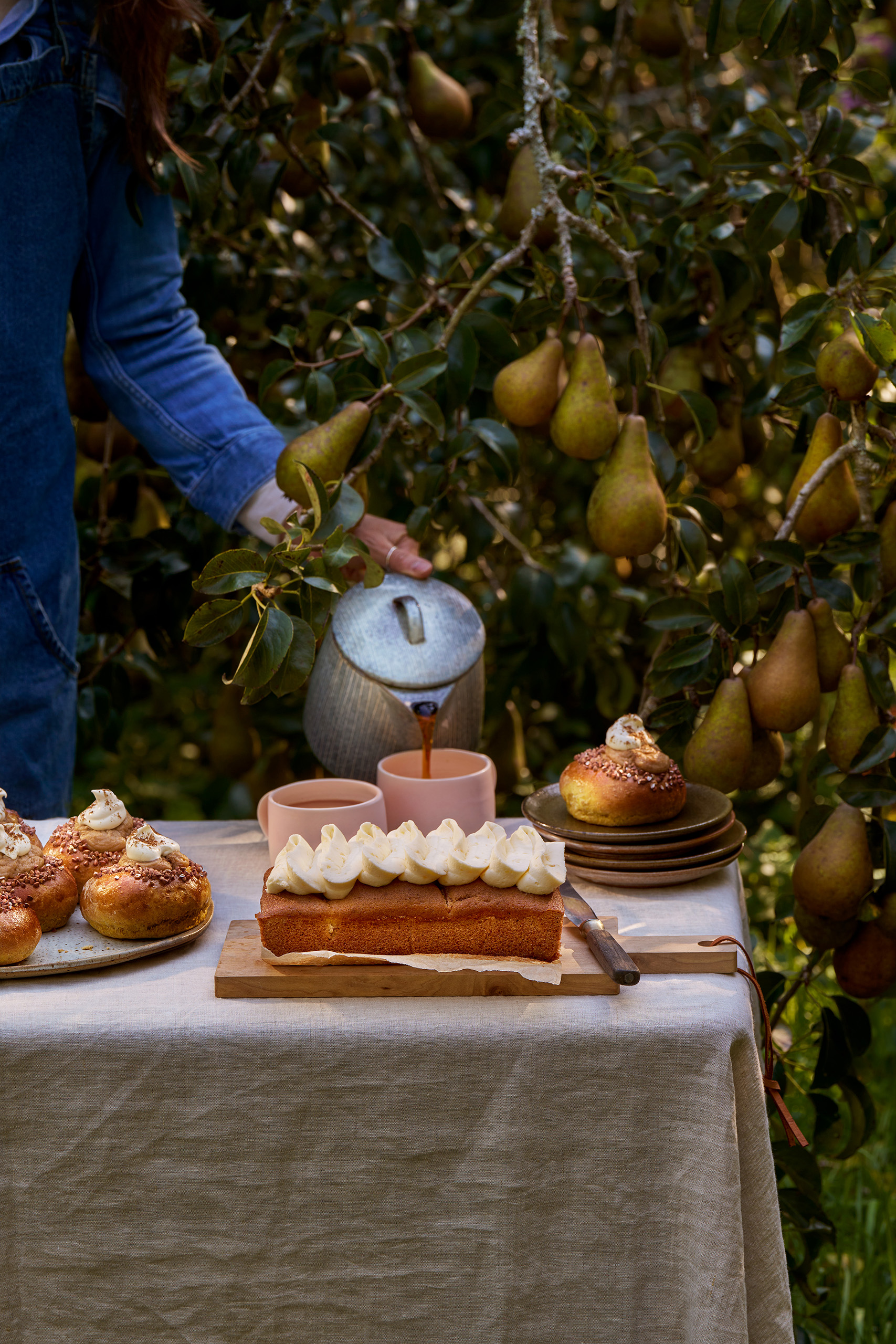Photographs and prop styling Kate Whitaker
Food styling Bianca Nice
Cake or Death’s vegan sticky toffee pudding
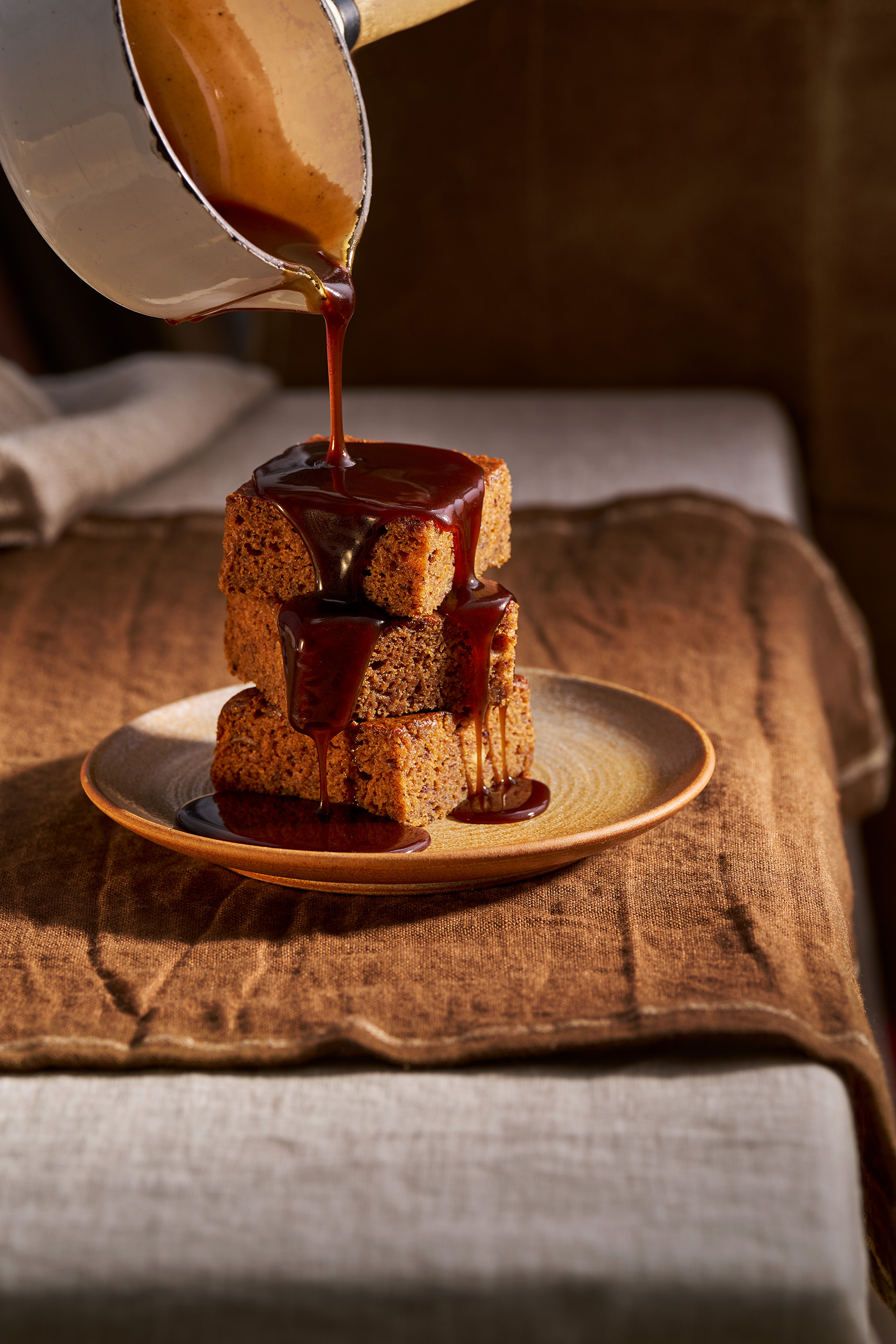
Katie Cross
Sticky toffee pudding is my all-time favourite dessert – we even served it at our wedding. We offer it every autumn at Cake or Death and it always sells out. You can easily make a vegan version of this decadent pudding and silky toffee sauce. I would add a scoop of your favourite ice-cream or custard for the perfect autumn dessert.
Serves 4-6
pitted dates 170g, chopped
plant milk 350ml (I use soy)
bicarbonate of soda 1½ tsp
vanilla extract 1 tsp
plant butter 115g
dark brown soft sugar 100g
self-raising flour 180g, sieved
mixed spice ½ tsp
ground cinnamon 1 tsp
fine salt 1 tsp
For the toffee sauce
dark brown soft sugar 250g
golden syrup 30g
plant cream 150ml (I use soy)
vanilla extract ½ tsp
plant butter 60g
Preheat the oven to 160C fan/gas mark 4.
To make the pudding, line a 20cm x 20cm square cake tin with greaseproof paper. You can use a 30cm x 20cm brownie tin too, but take 3 minutes off the cooking time.
First, gently cook the dates in the plant milk on the hob for 10 minutes until they are really soft, then cool. Stir the bicarbonate of soda into the cooled mixture.
Beat the vanilla, plant butter and sugar together, then stir into the cooled date mix.
In a separate bowl, add the flour, mixed spice, cinnamon and salt, and whisk to combine the ingredients.
Make a well in the flour mix and add the wet ingredients, then gently whisk together from the centre, without changing direction and gradually drawing in the dry flour mix at the edge, until fully combined (this should avoid lumps). The mix should be like a thick batter. Then pour the mixture into the tin and bake for 20-25 minutes, or until a skewer comes out clean.
While the pudding is cooking, make the toffee sauce. Put all the ingredients in a pan, apart from the plant butter. Cook on a medium heat, stirring constantly for 5-10 minutes to dissolve the ingredients, which should gently bubble away and thicken a little. Remove from the heat and melt in the plant butter.
Once out of the oven, prick the pudding with a fork and spoon over a little of the toffee sauce, leaving the rest to serve.
Katie Cross is the owner of Cake or Death bakery, Exeter; cakeordeath.co.uk
Spiced pumpkin custard buns
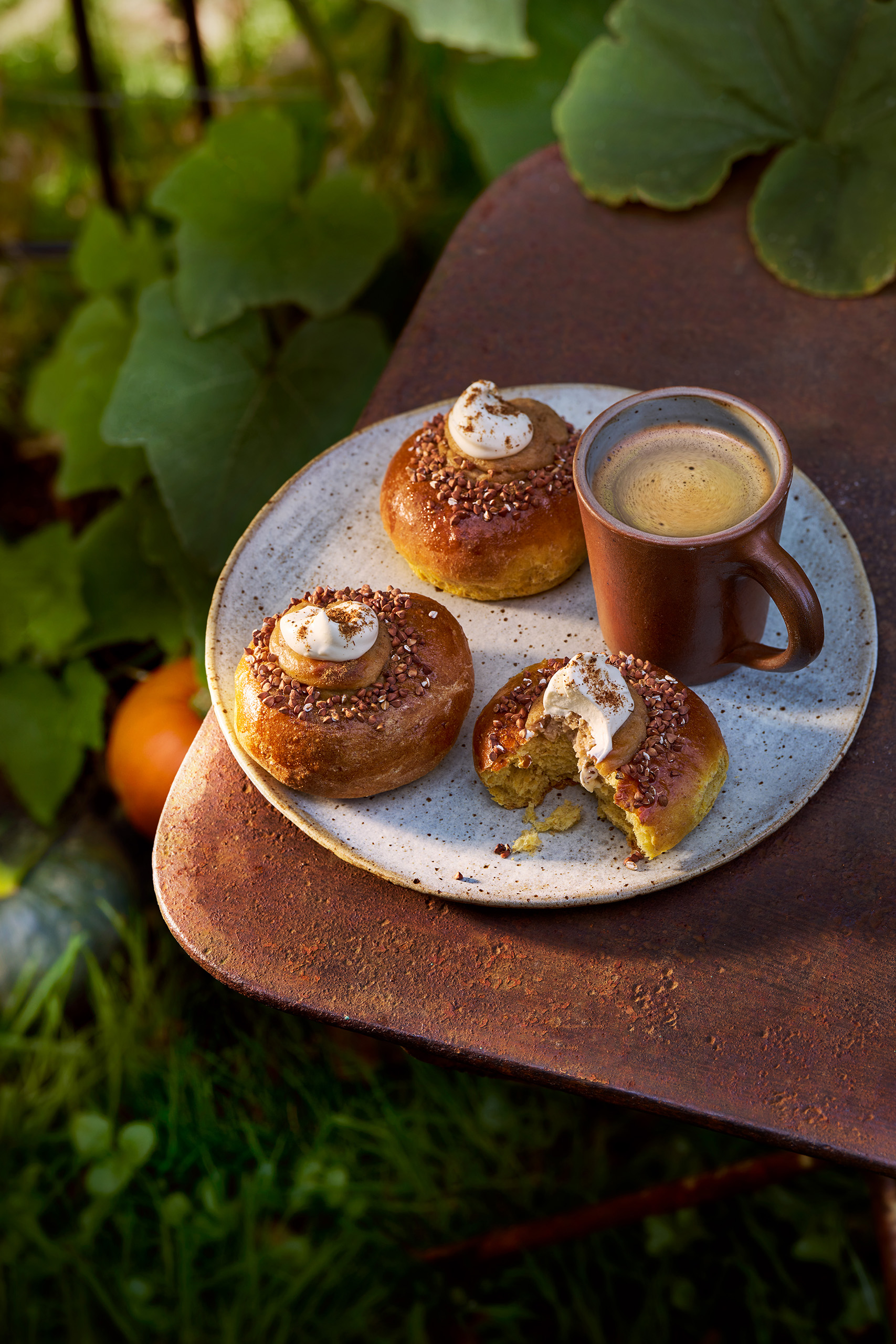
Thea Everett
The pumpkin spice brigade are a passionate bunch. Whether you are a disciple of the whipped-cream-adorned latte or not, these buns bring all the best flavours of a pumpkin pie with a lighter, more breakfast-like feel. Pumpkin is used in the dough and the custard, and buckwheat brings a pleasing crunch.
I love these buns because the dough itself is not too sweet, meaning that the spiced custard really shines. The whole thing is warm and comforting rather than overly sweet. Just the ticket on an October weekend morning.
You can make these buns with just strong white bread flour if you prefer, but I like the slight nuttiness that a bit of wholemeal brings. If you can’t find a small pumpkin, feel free to use half a butternut squash in its place. Ditto if you can’t find buckwheat groats, you could use baker’s sugar pearls for crunch.
Makes 9-10 buns
pumpkin 1 small (about 700g)
egg 1, beaten, for washing
buckwheat groats 3 tbsp
double cream 100ml, whipped
For the custard
ground nutmeg ⅛ tsp
ground cinnamon ½ tsp
ground ginger ¼ tsp
ground cloves ⅛ tsp
whole milk 350ml
egg yolks 4, about 15g each
caster sugar 100g
cornflour 20g, sifted
mashed roasted pumpkin 35g (from above)
cold unsalted butter 12g
For the dough
strong white bread flour 350g
strong wholemeal bread flour 100g
whole milk 120ml
mashed roasted pumpkin 165g (from above)
instant dried yeast 7g
sugar 20g
salt 1 tsp
eggs 2
unsalted butter 65g, cut into chunks
Turn your oven on to 160C fan/gas mark 4. Cut the pumpkin into 5-6 wedges, removing the seeds and fleshy innards. Place on greaseproof paper on a baking tray and roast in the hot oven for 45 minutes, or until it’s completely tender when poked with a sharp knife. Remove from the oven and allow it to cool for a minute or two, then peel off the skin and mash the flesh.
Mix together the custard spices in a small bowl. Set aside half of the mixture for sprinkling on the baked buns.
Make the dough. In a stand mixer, add the flour and all the rest of the dough ingredients except the butter, and mix everything together with a dough hook on a low-medium speed, until smooth and orange – this takes about 3 minutes. Rest the dough for 5 minutes.
Now gradually add the chunks of butter, piece by piece, until it has all been well incorporated into the dough – this takes about 5-6 minutes. Mix the dough very briefly on a high speed, then turn it off.
Oil a large bowl and place the dough in it, cover well and allow to rise for 1 hour on your countertop, then place in the fridge for 5 hours or overnight. (If you want to make the buns immediately, leave it on the countertop for 2-3 hours until doubled in size.)
Now it’s time to make the custard. Put the milk and half the spice mix in a medium-sized saucepan, place over a medium heat and bring just to a bubble. Turn off the heat as soon as you see the bubbles and set aside for 15 minutes to infuse.
When there is 5 minutes left of infusing time, in a stand mixer or by hand mix the egg yolks and sugar until pale, light and fluffy. Add the sifted cornflour, followed by the 35g of mashed pumpkin, and whisk until there are no lumps. Now whisk 80ml of the warm milk into the eggs to temper the mixture.
Finally, add the remaining milk. Pour the mixture through a sieve back into the saucepan, agitating it to get as much through as you can. Place the pan back over a medium-high heat, whisking constantly for about 2-3 minutes, until thickened and slowly bubbling on the surface. (You might think it isn’t going to thicken up but trust in the process and be patient.)
Once it starts vigorously bubbling, cook for 2 minutes longer, constantly whisking. Take off the heat, and whisk in the cold butter. Cover the custard bowl with clingfilm to avoid a skin forming, and bring it down to room temperature in the fridge.
Remove your dough from the fridge. Divide it into 9-10 buns of about 90-95g each. Shape the buns into balls by cupping them in the palm of your hand and moving your hand in clockwise circles with the dough inside it, so you create a taut top. Seal any seams at the bottom of the buns by pressing them together with your fingers, and leave the balls for another 30 minutes to 1 hour to prove. You know they are ready when they bounce back by half when you poke them.
Now make a divot in each bun using the bottom of a small glass dusted with flour or the floured end of a rolling pin. Leave a 1.5cm border around the edges. Place 1½ tbsp of spiced custard in each divot and egg wash the edges of your buns. Sprinkle the border with buckwheat groats. Turn the oven up to 170C fan/gas mark 5 and bake the buns for 20-25 minutes or until golden all over. The custard will shrink a little, à la pastel de nata.
Cool the buns for 15-20 minutes. Whip the double cream until it forms soft peaks, then pipe or dollop some on each bun and dust with the reserved pumpkin spice mix. Enjoy.
Thea Everett is a food writer and her Substack is What’s That You’re Cooking, Thea?
Double-ginger cider cake
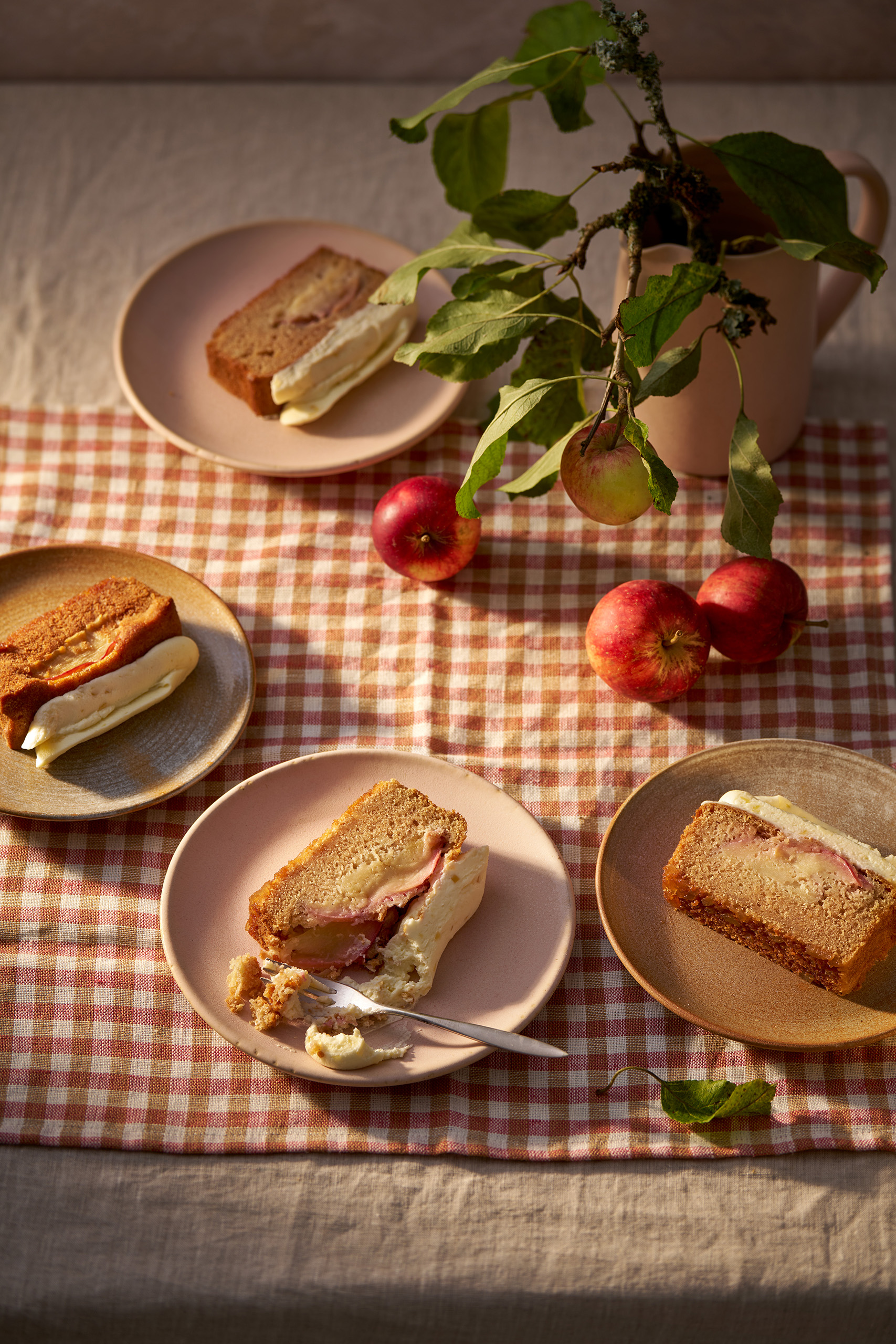
Holly O’Neill
I like the idea of chocolate Guinness cake, but I don’t really love stout, so never have it to hand to use in recipes. I do love cider, and often have it at home, to drink and cook with. I also always have stem ginger, which here is used to create a chewy, caramelised base.
It’s quite nice to have a recipe for two cakes – one for now, and one for the freezer, or a friend.
Makes 2 loaf cakes
stem ginger 2 balls, finely chopped, about 3-5mm
caster sugar 275g
sparkling cider 250ml
butter 250g
light creme fraiche 150g
eggs 2
ground ginger 3 tsp
ground cinnamon 1 tsp
plain flour 350g
baking powder 2 tsp
bicarbonate of soda ½ tsp
small apples 2, core removed, sliced about 3mm thick
For the icing (makes enough for both cakes)
unsalted butter 100g, softened, at room temperature
icing sugar 60g
stem ginger 2 balls, finely chopped
stem ginger syrup 2 tbsp
flaky sea salt a pinch
cream cheese 400g, at room temperature, drained of any excess liquid
Preheat the oven to 160C fan/gas mark 4. Butter 2 loaf tins (11cm x 22cm) and line with baking paper.
In a small bowl, toss the 2 chopped stem ginger balls with 1-2 tbsp of the sugar, then scatter over the base of the tins.
Put a medium-large wide pan on a hob over a medium heat. Add the cider and the butter, and heat, stirring occasionally, until the butter has melted. Turn off the heat. Whisk in the remaining sugar.
In a bowl, whisk together the yoghurt, eggs and spices, then whisk that mixture into the melted butter mixture.
Whisk in the flour, baking powder and bicarbonate of soda, just until everything is evenly combined.
Divide the mixture between the 2 loaf tins. Push in the slices of apple, peel facing up. Bake for 35-40 minutes, or until risen and golden and a skewer inserted into the centres comes out clean. (If the tops are browning too much, cover loosely with foil.)
Remove from the oven and leave in the tins to cool.
To make the icing, beat the butter with the icing sugar until pale and fluffy. Add the chopped ginger, ginger syrup and sea salt, and beat together. Add the cream cheese and beat until it’s just combined. Don’t over-mix.
Spread the icing over the cooled cakes. If you’re freezing one cake, make half the amount of icing, or freeze the icing separately, and defrost with the cake when needed.
Holly O’Neill is the deputy editor of Observer Food Monthly
Feta, white chocolate and cherry cookies
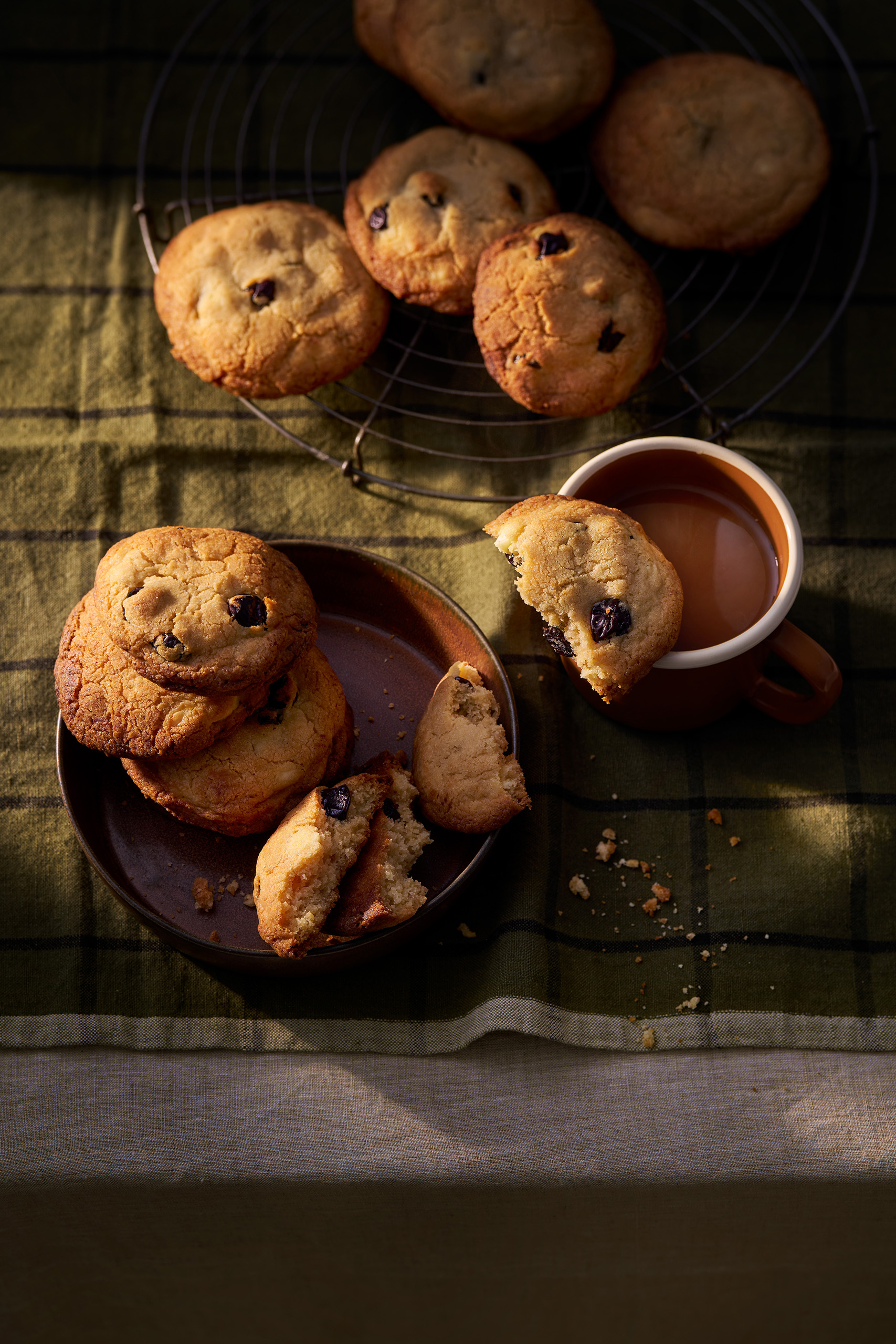
Georgina Hayden
If summer is about light food and fresh produce, I think of autumn as a time to open up the store cupboard and make the most of what I have. I always have an open packet of feta kicking around my fridge. Adding cheese to cookies sounds like a gimmick, and it is unusual, but it really works here. Sometimes I want a classic cookie, not necessarily with chunks of chocolate, but salty-sweet-squidgy combinations always work.
Makes 12
unsalted butter 160g
white chocolate 100g
light brown soft sugar 125g
caster sugar 125g
egg 1 large
plain flour 275g
baking powder ½ tsp
fine sea salt ½ tsp
feta 100g
dried cherries 75g, sour if possible, or dried cranberries
Cut the butter into cubes and add to a small pan over a medium heat. Melt the butter, then take it a little further so it turns golden brown and starts to smell nutty. You’ll see little flecks of brown, toasted butter solids at the bottom of the pan.
Meanwhile, chop the white chocolate and place in a large mixing bowl. Pour over the melted butter, leave for a minute, then stir until smooth. Beat in both types of sugar. Beat in the egg.
In a separate bowl, whisk the flour, baking powder and fine sea salt together. Add to the chocolate mixture and stir until it all just comes together. Crumble in the feta, add the dried cherries and mix briefly.
Line two baking trays with greaseproof paper and shape the cookie mixture into 12 even-sized balls. (Not to be a geek, but I weigh the dough and divide by 12. You’re looking at 80-85g per cookie.)
Place on the trays and make sure there is plenty of room between the balls. Place the trays in the fridge for at least 1 hour to help the mixture firm up so the cookies don’t spread too fast – the longer you leave them, the more domed and chewy they will be.
Preheat the oven to 180C fan/gas mark 6 and bake the cookies for 18 minutes, until a deep golden brown at the edge. If you have chilled the dough overnight, they might need a minute or two longer. Leave the cookies to cool completely on their trays before serving or storing in an airtight container.
Georgina Hayden is the author of Greekish (Bloomsbury, £26). Order a copy for £23.40 at observershop.co.uk
Plum, blackberry and apple crumble
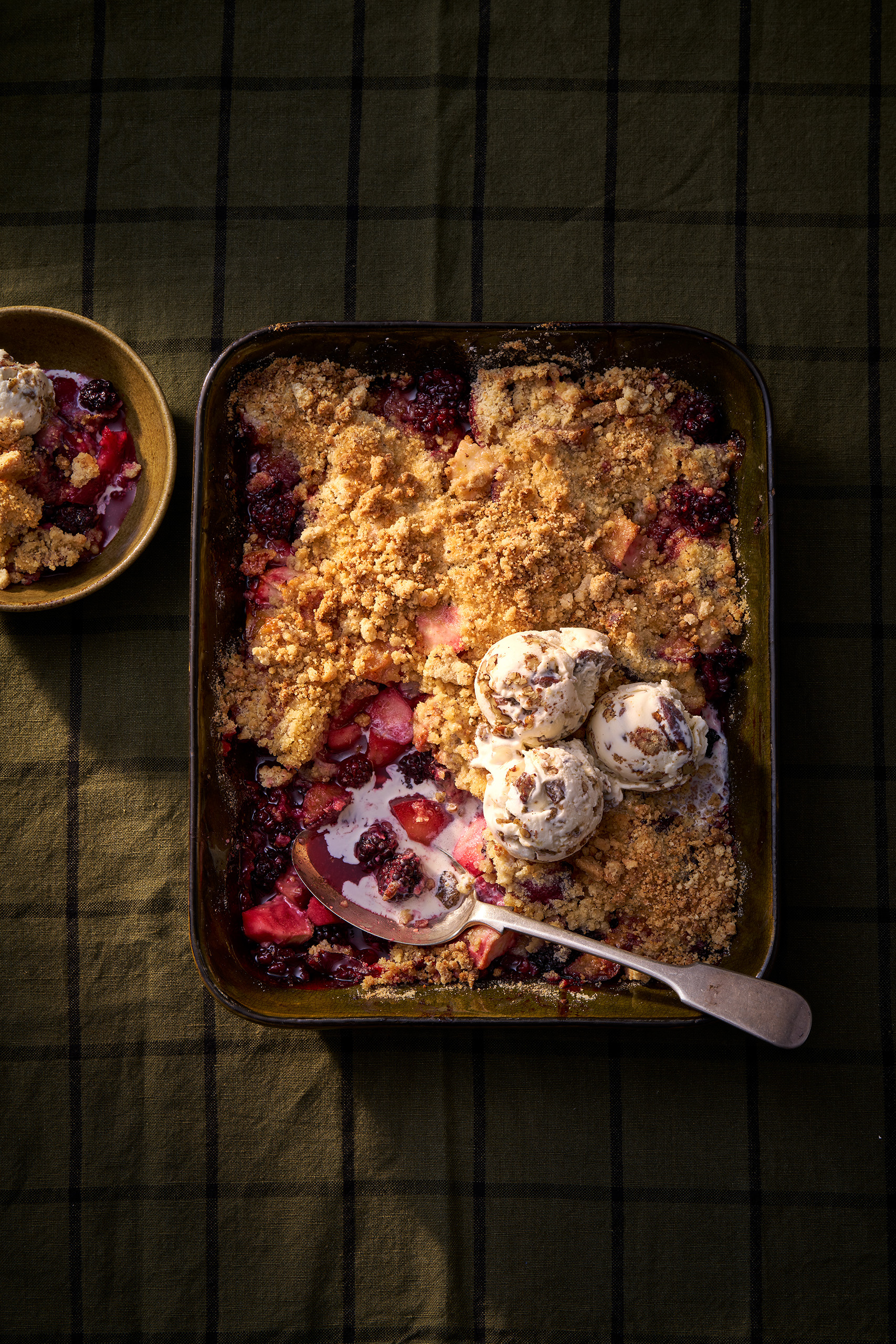
Tarunima Sinha
Double crumble is the only way I go – an almost equal ratio of fruit to crumble with lots of extra crunchy bits. Plums add a beautiful colour, blackberries are abundant in autumn and a couple of chopped apples hold it all together.
There is an extra step in this simple pudding, but I really think it is worth it. Make the crumble topping and divide it into two – one half goes on to the fruit and the other half is baked on a tray separately. This way, when it comes to serving, everyone gets enough crumbly, biscuity bits. I think it might be your new way to make a crumble.
Serves 6-8
eating apples 3 (I use braeburn), peeled, cored and chopped into 1cm cubes
plums 6-8 (I use rosa verde), stoned and cut into rough cubes
caster sugar 100g
sea salt flakes 1 tsp
lemon zest and juice of 1
cornflour 2 heaped tbsp
blackberries 2 punnets (about 360g)
For the crumble topping
plain flour 450g
ground cinnamon 1 tbsp
nutmeg ¼, freshly grated
salt 1 tbsp
caster sugar 175g
vanilla extract 1 tbsp
ground almonds 100g (optional)
cold butter 250g, cubed, plus extra for brushing
demerara sugar 50g
almond flakes 75g (optional)
To make the crumble topping, put the flour, spices, salt, caster sugar, vanilla extract and ground almonds, if using, in a large bowl. Give it a stir. Rub in the butter to a coarse knobbly texture. I use my fists to make small rough pebble shapes as I go along.
Divide the prepared crumble mixture into two. Put one half of the crumble in a freezer bag and put it in the freezer for 30 minutes. Keep the rest of the crumble aside.
Preheat the oven to 160C fan/gas mark 4.
In a large bowl, add the chopped apples and plums, the caster sugar, sea salt, lemon juice and zest, cornflour and the blackberries. Give it all a good stir.
Take a large baking dish (25-30cm in diameter) and brush with butter. Put the fruit mixture into the dish in a single layer.
Dot the unfrozen crumble mixture all over the fruit. Sprinkle over half of the demerara sugar.
Place the baking dish on a baking tray to catch any drips. Place it in the preheated oven for 30 minutes.
Check after 30 minutes – if it is browning too much, then place a piece of tin foil over it.
Now take another baking tray and line it with baking paper. Add the remaining crumble mix from the freezer, spreading it evenly in chunks. Sprinkle over the remaining demerara sugar. Bake this simultaneously on a second shelf to a light golden colour.
Bake both trays for another 25-30 minutes. Ten minutes before the end of the bake time, sprinkle the almond flakes over both trays, if using.
The fruit crumble is ready when the topping is light golden and the fruits are soft and yielding and oozing around the sides.
Once ready to serve, add most of the extra baked crumble on the top of the fruit crumble, leaving some to take to the table so people can add more.
This is delicious with pecan and brown butter ice-cream (see below for recipe).
Tarunima Sinha is a food writer, baker and the author of My Little Cake Tin (Quadrille, £22). Order a copy for £19.80 at observershop.co.uk
Pecan and brown butter ice-cream
Makes enough for 6-8 servings
butter 4 tbsp
pecan halves 75g
light brown soft sugar 40g
sea salt ½ tsp
vanilla essence ½ tsp
good quality vanilla ice-cream 500ml, slightly softened
In a large frying pan, add the butter. Let it cook until it is brown and nutty, giving it a swirl often, This will take 8-10 minutes. Add the pecan halves, give it a stir. Add the sugar, sea salt and vanilla. Stir until the sugar melts. Pour it over a tray lined with baking paper and let it cool completely.
Once cooled, crush it slightly and mix it into the softened vanilla ice-cream. Place it back in the freezer until needed.
Tarunima Sinha is a food writer, baker and the author of My Little Cake Tin (Quadrille, £22). Order a copy for £19.80 at observershop.co.uk
